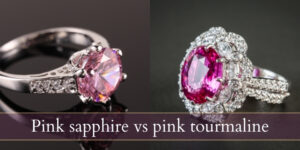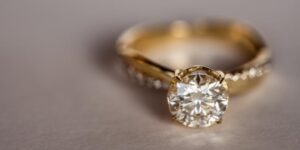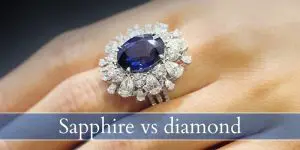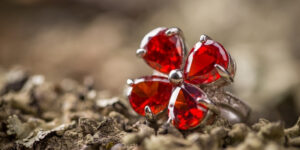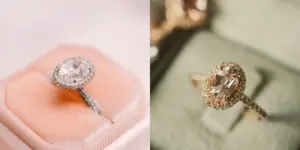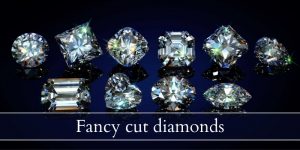Diamonds and moissanites have a long history together and their relationship is very strained. On the one hand moissanites made the diamond-like sparkle available to more people, and on the other hand a social stigma arose around wearing moissanite. Today moissanite is better understood and people don’t wear it as a diamond simulant as much as they used to. Still, the comparison stands: diamond vs moissanite is a very good debate and both gemstones have their pros and cons. Let’s go through them.
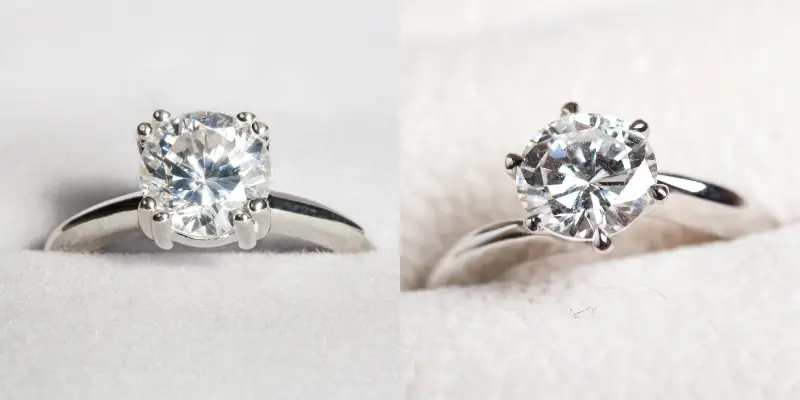
Diamond vs moissanite
Diamonds are tougher than moissanite and have a balanced fire-to-brilliance ratio, while moissanites have more fire than brilliance. Diamonds are also far more expensive than moissanites and come with the prestige of a natural, earth-grown gemstone. You’ll also find that most moissanite is crisp white while many diamonds have a little bit of a yellow tint, as the crisp white diamonds are too expensive for the general population.
Overall both moissanite and diamond are very good gems for an engagement ring, and they’re both going to look great even decades later.
What is diamond ?
Diamond is the crystallized form of pure carbon, with trace amounts of nitrogen (it gives the yellow tint). These are the toughest gemstones in existence, and the fact that they’re completely natural makes them even more impressive.
Diamonds have been around for centuries and have been very popular with nobility, and are currently the most coveted gemstone when it comes to engagement rings. Price points for diamonds vary immensely, depending on cut quality, clarity, color, and carat size.
What is moissanite ?
Moissanite is a lab-grown version of the natural moissanite, which is incredibly rare. So rare that it’s economically better to create the gemstones in a lab than look for the natural, exceedingly rare ones in the Earth’s crust. All moissanite on the market is lab-grown.
These gemstones have incredible sparkle, and a bit more fire than brilliance. They’re also judged by the four Cs: cut, color, clarity, and carat size. You can find moissanites in white or colored, but for the purposes of today’s comparison we’re comparing white, clear moissanite with white, clear diamonds.
Read also: Do Diamonds Turn Yellow ?
Diamonds are a bit tougher than moissanite
Both moissanite and diamonds are incredibly tough materials. Diamonds score a 10 out of 10 on the Mohs scale, while moissanite scores a 9.25 on that same scale, just a bit over sapphire (9). So while diamonds are tougher than moissanite, this doesn’t mean moissanites are soft or going to scratch easily. The difference between them is great but both are tough enough to withstand daily wear and tear, and are exceptionally great at keeping their shine.
Moissanite is far more affordable than diamond
The price difference between moissanite and diamond is incredible, with moissanite being 12-15 times more affordable. The usual price range for a 1 carat diamond is $7,000-12,000 depending on color, clarity, and cut quality. A 1 carat moissanite averages for $300-500, depending on where you buy it from.
All this adds up to a very affordable engagement ring if you’re going the moissanite route. Not only will the ring sparkle and dazzle everyone, it won’t requite monthly payments.
Diamond is natural, moissanite is lab-grown
So budget is one thing, but knowing you own a natural gemstone can mean the world to some. This is why diamonds tend to be regarded as better, or more impressive than moissanite. They are faceted and cut a certain way, yes, but only to reveal the inner beauty all diamonds possess.
Meanwhile moissanites are lab-grown, which is a deal-breaker for those who love diamonds for their natural appeal. For them the sparkle and look of a moissanite can seem fake or tacky. Of course, these are highly personal choices and opinions and each side has their good points.
Moissanites come with less prestige than diamonds
There is something to be said about natural gems, dug up and faceted and then set in jewelry. They bring something almost magical that lab-grown gems don’t. But would you know a gem is lab-grown instead of natural if it didn’t have a label or if it didn’t say so on the certificate ?
Nevertheless, moissanites do come with less prestige than a diamond, and this is something you really need to take into account if the person you’re proposing to places a lot of emphasis on natural vs lab-grown gems. If you’re in the position to find a ring for someone like this, try to find out whether they prefer a natural stone or are fine with a lab-grown one, to spare both of you some heartache.
Moissanite has more fire than diamond
There is a difference in sparkle between diamond and moissanite. Due to the refractive index of moissanite (2.69), the same cut applied to a diamond and a moissanite would result in more rainbow sparkle (fire) in a moissanite. This is simply the way these gems work, they have a more colorful sparkle than a diamond.
Moissanites look better in a crushed ice cut than diamonds
This is why moissanites are usually the ones you’ll find in crushed ice cuts. Crushed ice is the term applied to the effect some facets have, where the sparkle are much, much smaller, like crushed ice instead of chunks of ice. This of the tiny sparkles at the tip of a pear cut diamond, or the ones on either end of an oval cut diamond.
In a diamond a crushed ice cut would show the body color (yellow tint) more, since the white flashes will show a bit of yellow. But in a moissanite the rainbow sparkles are much smaller, which just makes them more similar to an actual diamond.
So if you like moissanites but want a bit less fire, go for a crushed ice cut. The most common are the cushion and radiant variations.
Diamonds tend to have a yellow tint, moissanites are crisp white
Both diamonds and moissanites are clear gems, and they’re both capable of a bit of a yellow tint. But diamond are usually warmer than moissanites, simply because moissanites are easier to manufacture in a whiter, cooler shade. Meanwhile diamonds are only as cool or as warm as they form in the Earth’s crust.
Overall, you’ll notice that moissanites are whiter. This, coupled with the very high price for a D-F color diamond, makes most people look for and actively choose near-colorless G-J diamonds. Partly due to lower prices, and partly because the extremely bright and white diamonds are often confused for moissanites, as these D-F diamonds are amazingly expensive.
Is wearing moissanite as a diamond tacky ?
Wearing moissanite for what it is – a standalone gemstone – is not tacky. Wearing moissanite and trying to pass it off as a diamond ? Tacky, yes, and people will eventually figure out the difference.
There’s a whole issue around whether moissanites should even be worn, since when they came about they were meant as diamond simulants. Nowadays they’re seen as a bit tacky, like if you’re trying to fool people into thinking you’re wearing diamonds when you’re actually wearing moissanite. But it’s never about the moissanite, in the end. It’s about the people.
In our (very) personal opinion moissanite should be worn as-is, as a standalone gemstone instead of a diamond simulant. When you really compare the two, you can notice that one is moissanite and one is a diamond. But does this make moissanite less beautiful ? No.
Part of the stigma around moissanite is its lower price point, which is in turn due to how readily available it is (lab grown).
Lab diamonds – compromise between moissanite and natural diamonds
So if you’re looking for something more affordable, but don’t want to go the moissanite route, then lab grown diamonds may be a good compromise. These diamonds are chemically the same as natural diamonds, but tent to be a bit clearer and a bit whiter because the environment is easier to control.
Lab-grown diamonds generally sell for 60% of a natural diamond’s price. So you’d still be paying a pretty penny for the diamond, but not as much as you would for a natural diamond.
The only way to know the difference between natural and lab grown diamonds is to look at the girdle with a magnifying glass. Each lab diamond has a serial number lasered into the girdle. Other than that there really isn’t anyway to figure out the difference.

I’m the main author for jewelrymaterialguide.com. I started this site after we did tons of research before our wedding and noticed that there is information about rings, jewelry, and so on that is really hard to find on the internet.

